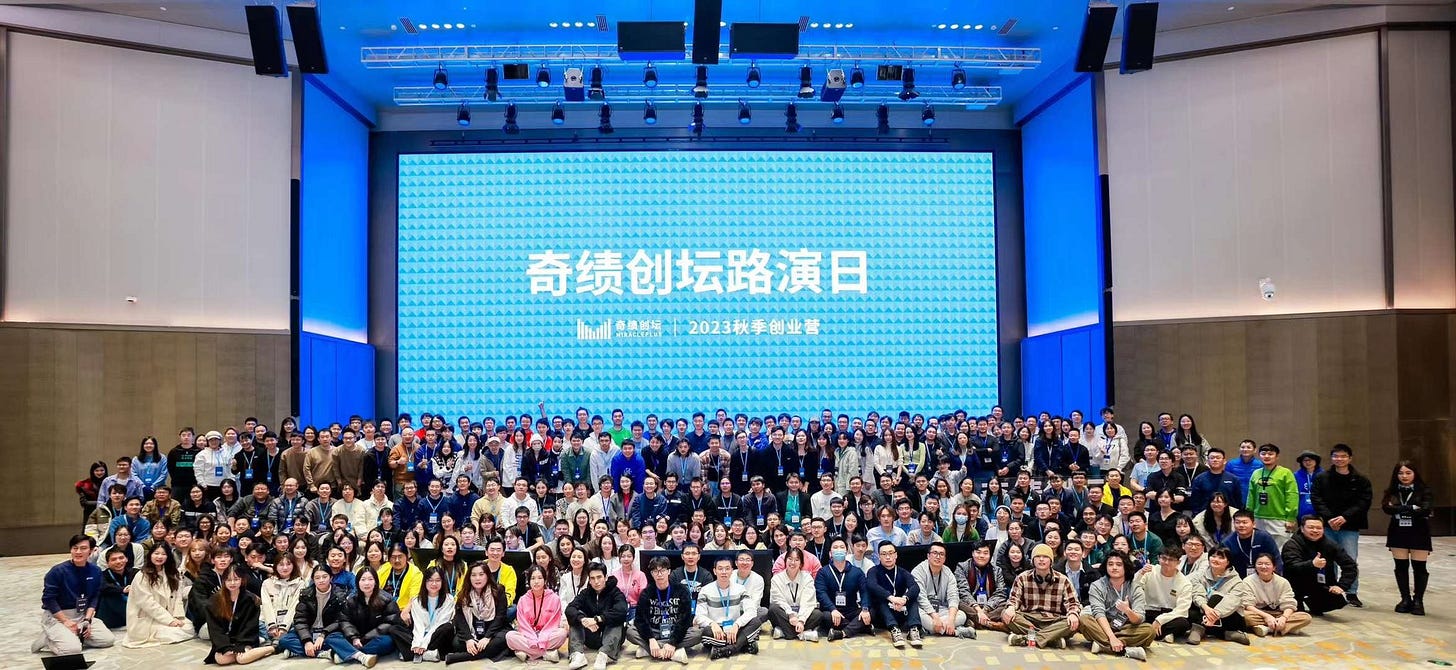👩🏻💻ByteDance Launches AI Co-worker, AI Dominates China's 'YC' Demo Day, and Alibaba Exits Quantum Computing
Weekly China AI News from November 20 to November 26
Hello readers, in this week’s issue, I will discuss ByteDance’s innovative AI assistant for Feishu. MiraclePlus’ demo day just wrapped up, and almost 80% of finalist projects are about AI. Alibaba has donated its quantum lab to Zhejiang University. Plus, don’t miss our trending research this week on the latest White-box Transformers!
ByteDance Introduces AI Assistant As Everyday Co-worker
What’s New: ByteDance’s enterprise collaboration app, Feishu, introduced an AI assistant designed to be your everyday AI co-worker last week. The AI assistant, powered by LLM, can summarize work chats and documents, write emails, analyze business data, and create CRM systems, according to Feishu CEO Xie Xin. Unique to Feishu, the AI assistant can memorize employees’ activities and provide personalized recommendations.
The Feishu AI assistant will be provided for free trials to paying enterprises and will open applications for external trials. The first batch is limited to 10,000 spots.
How It Works: Each employee can personalize their AI assistant, choosing a preferred avatar and name. This personalization, combined with the assistant’s memory of the user’s activities on Feishu, enhances its understanding and effectiveness. The assistant is also open to integration with third-party business applications deployed on Feishu.
Feishu also released an open AI framework where enterprises can choose from various third-party foundation models to find their best fit and build a custom AI assistant for the whole company.
For example, Shumi Technology, a B2B company, leveraged the AI assistant for sales management, which led to an increase in monthly revenue. Sparkling water maker Chi Forest used it for automated order dispatching.
Why It Matters: Feishu’s launch of an AI assistant signals its foray into AI, in response to moves by rivals like Alibaba’s DingTalk and WPS, who have already ventured into AI. Developments like ChatGPT and Microsoft’s Copilot, showcase a growing trend in leveraging AI to boost productivity in the workplace sector, and business clients have demonstrated a strong willingness to pay for AI.
AI Dominates MiraclePlus' Autumn Demo Day
What’s New: MiraclePlus, formerly Y Combinator China, hosted its autumn demo day in Beijing last week to discover the next “China’s OpenAI”. The demo day selected 67 projects from 8,283 applicants, with 51 projects related to LLMs and 34 featuring AI agents. You can find the full list here.
Why It Matters: The event highlighted a strong inclination among Chinese early-stage entrepreneurs toward AI innovations.
How It Works: The projects ranged from AI agents and robotics to cutting-edge chip technology, including blockchain-linked chip development. However, there was a notable absence of cryptocurrency-focused projects.
Gaming and education are two ever-popular domains that saw numerous integrations with AI agents. For example,
AgentLive is a startup that focuses on creating AI-native games with original gameplay, where players use natural language to drive AI combat.
MathGPTPro offers an AI question-and-answer app and provides APIs for ed-tech companies for question-answering, homework grading, and test creation.
Robots are the second most popular domain. Finalists include a restroom cleaning robot, a laundry robot that can wash, dry, and fold your clothes, a home cleaning robot, an airship drone robot, and more.
I’m particularly interested in two startups in data corpus and computation.
NoEdgeAI claims they can transform underutilized documents into valuable multimodal training datasets, thanks to its innovative recognition framework.
CMS is developing a platform that accelerates the computation of tens of thousands of chips for one task, such as training an LLM.
Alibaba’s Damo Academy Donates Quantum Lab and Resources to Academia
What’s New: Alibaba’s Damo Academy has donated its Quantum Laboratory, along with its equipment, to Zhejiang University, opening it to other academic and research institutions. This move confirms recent media reports about the lab’s closure due to budget and profitability concerns.
How It Works: The Quantum Laboratory, a key part of Damo Academy's cutting-edge technology strategy since 2013, was pivotal in Alibaba’s quantum computing research. It aimed at significant milestones, such as developing a quantum computer prototype with 50-100 qubits by 2030 and applying quantum simulation for major tech challenges. The lab made notable progress, including developing the world’s most potent powerful circuit simulator "Tai Zhang" in 2018 and launching the Alibaba Cloud Quantum Development Platform (ACQDP) in 2020.
Why It Matters: The closure represents a significant shift in Alibaba’s approach to quantum computing, a field known for its intensive research and development costs. While the lab’s achievements were substantial, the decision to close and donate its resources indicates a strategic realignment towards more profitable ventures.
Weekly News Roundup
🇬🇧 Graphcore, a UK-based AI chip unicorn, has cut most of its staff in China and halted sales in the country.
💬 Microsoft would reportedly introduce Copilot to Chinese mainland enterprises and educational institutions from December 1st. However, a Microsoft insider clarified this as inaccurate and said the service is for clients with overseas operations.
💰 Baidu’s Q3 financial report shows a revenue of 34.447 billion yuan, with a net profit of 7.3 billion yuan, a 23% year-on-year increase. Baidu said over 10,000 enterprise clients have been using ERNIE APIs on a monthly basis since they became available on August 31st.
🛒 Pinduoduo has reportedly built an LLM team in Shanghai, focusing on customer service and conversational AI applications, extending to its cross-border e-commerce platform TEMU.
🌐 The Guangdong Provincial Government releases a three-year action plan for the “Digital Bay Area”, focusing on AI talent development and high-end computing.
🔌 Nvidia's CFO, Colette Kress, confirms at the Q3 earnings call that Nvidia is developing new AI chips for China.
Trending Research
This paper introduces a novel approach in representation learning, aiming to transform data distributions into low-dimensional Gaussian mixtures on incoherent subspaces. It introduces sparse rate reduction as a measure to evaluate representations, combining information gain and sparsity. The study shows how transformers can optimize this measure, leading to interpretable CRATE architectures, effective in both encoding and decoding. These architectures perform comparably to complex transformer models, demonstrating a theoretical and practical bridge in deep learning via data compression. Read the paper White-Box Transformers via Sparse Rate Reduction: Compression Is All There Is?
T-Rex, an interactive object counting model, uses visual prompts for open-set object detection. Users mark objects on images to guide detection and counting, with interactive accuracy refinement. Excelling in class-agnostic benchmarks, T-Rex demonstrates strong zero-shot abilities and versatile applications in visual prompting scenarios. Read the paper T-Rex: Counting by Visual Prompting.
PANDA, a deep learning approach, accurately detects pancreatic lesions via non-contrast CT, offering a potential tool for large-scale pancreatic cancer screening. Trained on 3,208 patients, it surpasses radiologist performance in sensitivity and specificity. Validated across multiple centers, PANDA achieves high accuracy, demonstrating non-inferiority to contrast-enhanced CT in identifying pancreatic lesion subtypes. Read the paper Large-scale pancreatic cancer detection via non-contrast CT and deep learning on Nature Medicine.
HelixFold-Single, a rapid protein structure prediction method, uses only primary structures, merging a large-scale protein language model with AlphaFold2’s geometric learning. It predicts three-dimensional coordinates effectively, showing competitive accuracy on large homologous families with significantly reduced processing time, making it suitable for tasks needing numerous predictions. Read the paper A method for multiple-sequence-alignment-free protein structure prediction using a protein language model.











